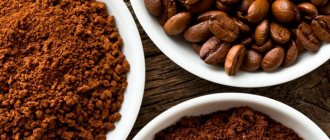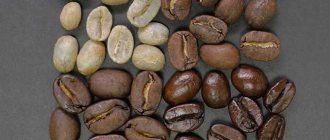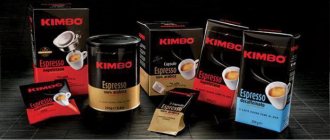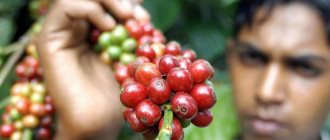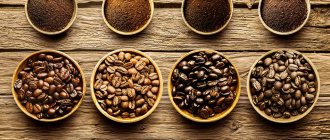It's difficult to talk about the taste of coffee. Mainly because most often the coffee brewed tastes bad. Over-roasted, stale, overly bitter or watery, with a moldy taste or sharp, unpleasant acidity, processed, roasted and prepared without much attention - all this is about coffee, found absolutely everywhere: from vending machines to fancy restaurants. You want to drown out this kind of coffee with milk and sugar, add spices to it to make the taste more pleasant.
The highest quality coffee with unique flavors is called specialty (from the English specialty - unique, special). This is approximately 10% of the world's coffee harvest. Specialty can only be Arabica : this type of coffee is softer and more acidic than Robusta, contains more aromatic components and less caffeine. Arabica beans are evaluated by certified specialists - Q-graders (from English quality grader - quality evaluator). Coffee is classified as specialty if it scores at least 80 points on a special rating scale. For a variety to receive a high rating, the beans must be free of defects, and the taste of the finished drink must be balanced, multifaceted and interesting. But what makes coffee so different, and where do these shades come from?
Coffee beans ripen in northern Thailand
How to name a Coffee Shop, interesting names
The combination of aroma and taste emphasizes the full palette of coffee. If this harmony is disturbed, the drink will turn out bitter and will lose its unique taste. It is difficult to describe the coffee taste in words. Some will find it bitter or bittersweet, others claim that there is a tart, even astringent, taste with barely noticeable sourness. The main thing about it is its unique, specific aroma. It seems that there is nothing more to add, but you must admit that such a meager description does not fit in with this divine drink.
Treatment
Processing is the process of separating the coffee bean from the berry. It can happen in different ways.
Dry processing, or natural processing, is a process in which coffee is dried for several weeks directly in the berry, which is then peeled. Dry-processed coffee has a lot of sweetness and fruity notes, but notes of fermentation—fermented fruits and berries—can be felt.
Washed processing - in this case, all the pulp is removed from the grain at once using special depulpators (devices for removing pulp). The coffee is then left in a fermentation tank (with or without water) where bacteria break down the gluten remaining on the beans. After this, the grains are washed and sent for drying. This processing method makes the coffee taste cleaner and more acidic.
Honey processing is similar to washed processing, but the coffee is dried along with the gluten, so more sweetness remains in this bean.
These are the most popular processing methods, but some countries also have their own traditional methods. For example, India produces monsoon-processed , which is distinguished by its special golden color and characteristic woody-spicy taste without sourness. This processing replicates the conditions under which Indian coffee used to be transported to Europe by ship: the coffee is exposed to hot, humid air and monsoon winds for weeks, creating its unique flavor profile.
Manual processing (cleaning and drying) of coffee beans in northern Thailand
What kind of coffee can be adjectives?
So many epithets for coffee: Fragrant... Tart... Hot... Classic... New... Refined... Unique... Intoxicating... Invigorating... Inspiring... Warming... Alluring... Soothing... Thick... Strong... Business... Romantic... Family... Fiery... Magical... Marvelous... Exciting... Sweet... Black... Creamy brown... With cream... With chocolate... With hot milk... With vanilla... With cinnamon... With pepper... Allspice... Spicy... All shades of feelings and emotions... The morning begins with it... sleep and dreams end with it... ... for pauses and intermissions... for inspiration... for negotiations and discussions... for simple chat... on the way and while stopping... ... for a book... for the press... for a film... ... in creativity... for ideas... for creativity... for implementation... ... In the East they say that One cup should contain only three sips of coffee - “the first is bitter, like life, the second, sweet, like love, and the third, mysterious, like death.” Baska Anna
Source of the article: https://fotostrana.ru/public/post/232138/1844648685/
General impression
Defects are bad tastes in the cup. For example, earthy, moldy, burlap-like chemical and other unpleasant descriptors can often be heard in commercial coffee. To thoroughly check for defects, the same coffee is brewed in 5 cups.
Only through the assessment of taste are interesting flavor “notes” discovered, but also their combinations with each other or possible defects. After all, understanding what we feel in the taste of coffee is important not only for professionals.
Dictionary for describing coffee taste characteristics
How to explain to people how you felt
4 min. 6841 views to read
Cupping is a universal way to evaluate the taste of coffee. First of all, descriptors are used to describe the taste of coffee. Cupping participants listen to the aroma of ground coffee, then evaluate the taste of already brewed coffee and try to find something familiar in them, for example: fruits or berries. We talked about descriptors in this article.
But if you describe only the taste and aroma, the picture will be incomplete. To complete the description of coffee, it is complemented by aftertaste, acidity, body and balance. We’ll talk about these criteria and their description today.
Aftertaste
The aftertaste is assessed when the coffee is swallowed or spat. This is a complex parameter that includes taste, aroma and tactile sensations. It is important that the aftertaste has positive characteristics.
Aftertaste is an important parameter that is assessed during cupping.
Source of the article: https://shop.tastycoffee.ru/blog/slovar-opisania-vkusa
Preparation
Even the best coffee can be “killed” by improper preparation. There are 3 most common mistakes.
- Improper storage. The grains should not come into contact with oxygen so that the aromatic substances do not evaporate. Choose a zip-lock bag, store your coffee in it, and drink the opened pack within a week or two to get the most out of your coffee. And don’t forget to look at the roasting date: coffee is especially good in the first two months, then it gradually loses its properties.
- Wrong grind. The smaller the coffee particles, the faster they release their flavor to the water. If you grind coffee too finely, the drink may be overbrewed: overly bitter, drying, and tasteless. Grinding too coarsely can make your drink tart, with an unpleasant acidity and lacking in sweetness. Uneven grinding will make a cup of coffee unbalanced, unclear and tasteless, so it is important to get a high-quality burr coffee grinder to get a tasty drink every day.
- Unsuitable water. Water that is too hard or too soft will interfere with the full flavor of the coffee. Use filtered water or choose bottled (not mineral!) water at the store.
Prepared coffee
Trying to describe the taste of coffee
The combination of aroma and taste emphasizes the full palette of coffee. If this harmony is disturbed, the drink will turn out bitter and will lose its unique taste. It is difficult to describe the coffee taste in words. Some will find it bitter or bittersweet, others claim that there is a tart, even astringent, taste with barely noticeable sourness. The main thing about it is its unique, specific aroma. It seems that there is nothing more to add, but you must admit that such a meager description does not fit in with this divine drink.
Drink body intensity (Body)
This is a characteristic of the totality of sensations on the receptors in the oral cavity that you experience when swallowing: texture (a term used to describe tactile sensations. Ranging from light, tea-like to thick and creamy), richness.
The tactile sensations of a coffee drink are formed due to oils and organic acids that are extracted during the preparation of the drink (extraction).
What is the character of coffee?
Connoisseurs of tea or wine use poetic definitions in the description - “delicate”, “elegant”, “honey” and similar parallels. But these epithets are definitely not suitable for coffee. The taste of this drink cannot be compared with anything! It is also difficult to characterize the “masculine character” of coffee with poetic colorful opuses.
So what determines the sensation of taste? In the modern world there are many methods of physical and chemical analysis, but no matter how hard science tries, it cannot replace humans. To determine the merits of a product, only a qualified taster can give a complete definition of taste.
Results
Specialty coffee is not just special, unique coffee, but also an entire culture with its own laws. The taste of coffee depends on its origin, growing conditions, processing, roasting and, of course, how it is prepared.
Coffee from different countries can be very different:
- from Ethiopia - floral,
- from Kenya, Burundi and Rwanda - berries,
- from Colombia and Costa Rica – citrus-tropical,
- from Brazil and El Salvador - nut-caramel,
- from India and Indonesia – woody-spicy.
But the taste of coffee is determined not only by the country of origin: it can be completely different in different regions or even on neighboring farms. It is impossible to describe all the tastes of coffee in one article: you need to try, and try a lot, in order to begin to notice and remember the differences.
If you want to learn more about the world of specialty coffee, go to a good coffee shop in your city, take filter coffee and drink it from a cup, without sugar or milk, slowly, trying to catch the nuances of taste. Or order freshly roasted beans from good roasters and try making your regular morning coffee with it - we assure you, you will notice the difference!
How we taste coffee
Coffee is not limited to taste sensations. There is a whole palette of different perceptions involved here. Imagine that the coffee turned a bright red color, would you perceive it the same as before? This means that all aspects of perception play a role in taste sensations: smell, taste, vision.
What is taste? From a scientific point of view, this is an effect on the taste buds. They are divided into four main groups: bitter, salty, sweet and sour, but the flavors are so varied that an accurate description would take thousands of pages.
The number of perceived odors is no less. We are able to distinguish more than 2 thousand odors, and, say, a perfumer-taster - up to 10 thousand.
Mixing smells and tastes adds tens of thousands more flavor combinations. Let's get back to coffee. Why is coffee bean drink so popular? The answer is simple: a coffee drink contains a wide variety of aromas, creating such amazing combinations of smell and taste that it is impossible to find the same in other drinks!
Many people are surprised by how attractive coffee is. The drink is so loved by many that businesses are eager to buy a coffee machine for employees and office visitors. The popularity of coffee is not determined by any one quality of the drink. It has everything: great taste, enchanting aroma, invigorating effects and many other pleasant, healthy qualities.
Source of the article: https://ruscoffee.ru/company/news/1013.html
Terroir
This French word, literally meaning "soil", came into the coffee industry from the wine industry. It refers to the totality of natural conditions in which coffee grew. The height of growth, the composition of the soil, the amount of precipitation and air temperature, the surrounding flora and fauna - all this contributes to the formation of the taste of the grain. For example, it is believed that the best coffee grows on volcanic soils : they are the most fertile and rich in essential minerals. Coffees from Kenya, Tanzania and Costa Rica, grown at the foot of volcanoes, are distinguished by the intense acidity of the red berries.
- Connoisseurs of bright acidity choose high-mountain coffee that grows at an altitude of 1600-2000 meters above sea level - such coffee can be found, for example, in Ethiopia, Kenya and Colombia. Due to temperature changes, coffee at such an altitude ripens more slowly and has time to absorb more nutrients from the soil: a drink made from high-altitude beans will be complex, bright and sweet.
- Coffee grown at low altitude (such as Brazilian coffee) will generally have a simpler, nutty, caramel-like flavor with low acidity.
Residents of northern Thailand harvesting coffee beans
Declension of the noun coffee
| Case | Question | Unit | Mn. number |
| Nominative | (who what?) | coffee | coffee |
| Genitive | (who, what?) | coffee | coffee |
| Dative | (to whom; to what?) | coffee | coffee |
| Accusative | (who, what?) | coffee | coffee |
| Instrumental | (by whom, what?) | coffee | coffee |
| Prepositional | (About who about what?) | coffee | coffee |
What (who) is coffee: (definitions are given in the nominative case)
Related phrases
Making the Word Map better together
Hello! My name is Lampobot, I am a computer program that helps you make Word Maps. I can count perfectly, but I still don’t understand very well how your world works. Help me figure it out! Thank you!
I will definitely learn to distinguish widely used words from highly specialized ones.
How clear is the meaning of the word well done
(noun):
Associations to the word “coffee”
Synonyms for "coffee"
Sentences containing "coffee"
- Next to the low coffee
table there were two light armchairs and a sofa, and at the table on one of the chairs sat a tall, skinny guy in a dark suit.
Quotes from Russian classics with the word “coffee”
- By evening, the whole of Balaklava smells unbearably of fish. In every home, mackerel is fried or marinated. The wide mouths of the bakery ovens are lined with clay tiles, on which the fish is fried in its own juices. This is called: mackerel on a fishnet - the most exquisite dish of local gastronomes. And all the coffee shops
and taverns are filled with smoke and the smell of fried fish.
The meaning of the word "coffee"
COFFEE, oh, oh. 1. Adj. To
coffee. Coffee plantations. Coffee beans. Coffee grounds.
(Small Academic Dictionary, MAS)
Submit Comment
Additionally
The meaning of the word "coffee"
COFFEE, oh, oh. 1. Adj. To
coffee. Coffee plantations. Coffee beans. Coffee grounds.
Sentences containing "coffee"
Next to the low coffee shop
There were two light armchairs and a sofa at the table, and at the table on one of the chairs sat a tall, skinny guy in a dark suit.
“Well, yes,” he answered gloomily, “so what?” – His hair shone brightly in the sun and smelled sharply of coffee.
On one of them there were two coffee pots
cups, on the other lay a large open book.
Synonyms for "coffee"
Associations to the word “coffee”
Associations to the word "coffee"
Morphology
Map of words and expressions of the Russian language
An online thesaurus with the ability to search for associations, synonyms, contextual connections and example sentences for words and expressions in the Russian language.
Reference information on the declension of nouns and adjectives, verb conjugation, as well as the morphemic structure of words.
The site is equipped with a powerful search system with support for Russian morphology.
Source of the article: https://kartaslov.ru/%D1%87%D1%82%D0%BE-%D0%B8%D0%BB%D0%B8-%D0%BA%D1%82%D0%BE- %D0%B1%D1%8B%D0%B2%D0%B0%D0%B5%D1%82/%D0%BA%D0%BE%D1%84%D0%B5%D0%B9%D0%BD% D1%8B%D0%B9
Connection with other words
Words containing -coffee-:
- tocopherol
Words starting with coffee:
- coffee maker
- coffee
- caffeine
- caffeineism
- coffee maker
- coffee
- coffee shop
- coffee pot
- coffee shop
- coffee
- coffee house
- coffee grinder
- coenzyme
Hypo-hyperonymic relationships
What is coffee like (adjectives)?
Selection of adjectives for words based on the Russian language.
hot strong black black morning cooled steaming fragrant fresh good Turkish real cold strongest sweet ground Brazilian brewed excellent thick bitter natural warm double tasty excellent liquid none fragrant caustic best cooked beautiful Colombian wonderful Arabic bad disgusting decent afternoon boiling wonderful Italian earthly necessary served drinking fried favorite magnificent bad normal expensive Irish evening ordinary yesterday's untouched crappy excellent brewed drenched French chilled
What can coffee do? What can you do with coffee (verbs)?
Selection of verbs for words based on the Russian language.
turn out to cool splash out drink run out spill boil stay seem drink cool get stand help boil wake up spill act cook render run away splash cook have time seem come out end cook refuse fill boil cost smoke fill make rise help splash appear make pour overflow soar rise fill invigorate pour out arrive hit have warm boil escape return burn arrive spill mix forget pour prepare pour spread ripen
Associations to the word coffee
milk cup hand cream cognac sugar table thermos bed cake bun caffeine mug living room kitchen liquor sandwich coffee pot morning tray chicory table brandy machine cup coffee maker ice office cafe bar stove toast pie donut night pie rum breakfast lip terrace house sink biscuit room Turk cigarette buffet restaurant milk day company saucer dining room dinner bagel library lemon room side floor fire veranda cinnamon knee
Hypernyms for coffee
- grain product
- drink drink
Scope of use of the word coffee
General vocabulary Food industry Slang Cooking Colloquial expression
How to correctly describe the taste of coffee
We tell you how not to get confused about the attributes of coffee taste at the championship, and how to tell the guest the most important thing in a coffee shop.
8 min. to read 13794 views
Baristas describe coffee differently for judges at a championship and for guests in a coffee shop. In the first case, they need to describe in detail all the components of taste, in the second, it is enough to name a few descriptors.
How they describe the taste of filter coffee at the championship
When describing the aroma, first of all, its character is described : sweet, rich, spicy, refreshing, and up to four descriptors are also called. The participant can recommend to the judges a way to better evaluate the aroma of the coffee. For example: he holds the vessel in his hands and thus invites the judges to familiarize themselves with the aroma.
When describing aroma and taste, it is recommended to name no more than four descriptors. They must be explicit, readable and understandable to judges. If the judge really smells them in the aroma, the score will be higher.
If a participant smells yellow tropical fruits, but does not understand which ones specifically, he says: “you will feel notes of yellow tropical fruits in the aroma.” For this he will be given slightly less points.
If he says that the taste contains mango, but the judge does not feel it, he will be given a low score.
Judges, on the recommendation of the participant, can taste coffee with a spoon or from a cup
The taste of a drink is the combined perception of all taste sensations from the aroma of coffee to the final aftertaste. Taste is described at three temperatures: hot - about 70°C, warm - 40°C and cold - 25-30°C. At each temperature, you need to name the main descriptors that the judges will feel.
The nature of the main flavor descriptor may change as it cools. For example, a hot cup will contain dark grapes, a warm cup will contain red grapes, and a cold cup will contain white grapes. Some descriptors may fade into the background, while others come to the fore.
The barista can advise the judges on how to judge taste: with a spoon or from a cup. In both ways, the taste is revealed differently. The acidity and sweetness will be better revealed with a spoon, this way the judge will spray the coffee throughout the mouth. And the body - if you drink coffee from a cup. This way the drink can be directed to the center of the tongue.
Aftertaste is the length of flavor that is felt on the back of the palate and lingers after a sip has been taken. First of all, the character and duration of the aftertaste are described: long, sweet, rich, refreshing.
Also called one descriptor each for hot and cold. Most likely, the aftertaste will change along with the taste. But it may also be that the aftertaste will remain.
For example: “the aftertaste is rich and long. When the temperature is hot you will taste cocoa, when it cools down you will taste dark chocolate.”
When describing acidity, the intensity is indicated: below average, average or above average. Quality: sweet, juicy, bright. And also the type of acidity: malic, citric, tartaric, lactic.
In most cases, acidity is described at two temperatures because it becomes more intense and juicier as it cools.
For example: “medium intensity acidity when the coffee is hot, and above average intensity when the coffee cools down. Complex, juicy, a little sparkling. Two types: wine and orthophosphoric.
Body - tactile sensations from the drink in the mouth. At the championship, the weight of the drink and the quality of the body (tactile sensations) are described. Body weight may be average, above average, or below average. And the tactile description: smooth, enveloping, silky, velvety.
We wrote about the body of the drink in a separate article.
For example: “the body is medium when the coffee is hot, and above average when it cools. Smooth, round."
Balance is the combination of different aspects of flavor, aftertaste, acidity, sweetness and body. The barista describes how well the coffee is balanced and talks about the strengths of his coffee at all temperatures. Balance does not imply equal proportions of all basic tastes, but rather their harmonious combination.
For example: acidity - above average, sweetness - average.
When describing taste at the championship, the participant is advised to move sequentially and not skip any of the attributes.
How they describe the taste of espresso at the championship
The description of the taste of espresso at the Barista Championship is shorter than the description of filter coffee at the Brewers Cup. As part of the Barista Championship, the participant prepares espresso for the judges and must describe its taste. This description is different from the description of filter coffee that a barista gives at the Coffee Brewing Championship.
The participant names the level of acidity, sweetness and bitterness in the taste: high, low, medium, above average and below average.
Judges evaluate espresso based on how these flavor parameters combine and complement each other. The same level of intensity does not mean a harmonious balance of flavors.
The description of the taste of espresso is shorter because it is assessed at one temperature in two sips.
The participant names up to four descriptors. However, they may change in the second sip, and the barista should say so. For example, “in the first sip you will taste orange and raspberry, and in the second you will taste raspberry and grapefruit.”
The participant can focus on the aroma if it complements his description.
The barista names the character of the aftertaste: long, sweet, rich, refreshing.
Just like in the Coffee Brewing Championship, the barista describes the weight of the drink and the body quality.
Weight may be average, above average or below average. Body quality: smooth, enveloping, silky, velvety.
At the Barista Championship, the score for taste balance is multiplied by 2, for the accuracy of the description of the bouquet - by 3, for tactility - by 4. Therefore, it is important to correctly and accurately describe these attributes in order to get more points.
How to describe coffee to a guest
There are several reasons for this: 1. Lack of time. The championship performance lasts 15 minutes. During this time, the participant can tell all the details about his coffee. In a coffee shop, the barista has a few seconds to communicate while dispensing a drink. And if during quiet hours of the coffee shop he can devote more time to the guest and tell him a little more about the taste of coffee, then during rush hour he will not be able to do this.
2. Lack of interest on the part of the guest. Not every guest is so interested in coffee and is well versed in its taste. Therefore, the barista’s task is to understand the needs of visitors.
To understand the guest and describe the coffee to him, you need to try to understand him. If the guest is interested, asks questions and is ready to try new things, you can tell us more about the balance of taste and tactile sensations. If not, just list a few taste descriptors that will characterize acidity, sweetness and bitterness in coffee. It is better to name them in the order in which the guest will feel them.
Educating guests and developing their taste experience helps them find a common language and understanding.
Is it important to be able to understand the taste of coffee and describe it?
He can always taste his drink and see if everything is okay with it. If a barista learns to distinguish herbal bitterness from tablet bitterness, he will understand what is wrong with his recipe and how to fix it. For a guest who has not previously been interested in coffee, it is difficult to find apricot or flowers in a cup of espresso. But if the barista describes the taste and talks a little more about it, the guest will become interested and try to find these descriptors in the coffee.
Source of the article: https://shop.tastycoffee.ru/blog/kak-pravilno-opisat-vkus-kofe
Genetics
Arabica is a type of coffee that has dozens of varieties: Typica, Bourbon, Caturra, Geisha, etc. Some varieties, for example, Bourbon, appeared as a result of natural mutations, others were bred by breeders.
Each variety has its own taste characteristics. For example, the taste of the Typica variety, from which most other varieties are derived, will be clean and sweet, floral - such is the taste of coffee from Ethiopia, the country considered the birthplace of coffee. Bourbon has complex acidity reminiscent of tropical fruits, while Caturra, derived from bourbon, has lemony notes and a light body. Of the selective varieties, the most famous coffees are SL-28 and SL-34, bred in Kenya by Scott Labs. These varieties are distinguished by juiciness and bright citrus acidity.
Collected coffee beans in the hands of a Thai farmer
There are other rules for selecting names:
- The name should leave no doubt that you can drink a cup of aromatic coffee here. With the word denoting a popular drink, you can find interesting options: “Thank you coffee”, “Coffee maker”, “Coffee of the world”, “Who wants coffee?”, “Coffee”, “Coffee philosophy”.
- Names that evoke associations with coffee and food are attractive: “Cupcake”, “Croissant”, “Cheerful Day”, “Sweet Tooth”, “Chocolate Girl”.
- The name does not necessarily have to be related to the activities of the establishment. These can be words or a group of words that evoke pleasant associations or sound beautiful: “Expression”, “Tulip”, “Mango”, “It’s mine”, “Chamber of Secrets”, “Maestro”.
- Names using foreign vocabulary will attract lovers of everything foreign. English is most often used: Coffee Lunch Market, Impress, Coffeeshop Company, Forget Me Not. But you can see signs in French: ÔPETIT (Oh God), Macaron (a type of cookie), La vie en rose (Life in Rose); German: Mary's Bagels, Waffel; Danish: Hygge (comfort), Italian: Est! Caffe, Presto Coffee. In most cases, foreign names, like Russian ones, contain the word “coffee”, sometimes the name of the variety, famous brands, names: Magic Coffee, Latte Art, Luigi, Maya, Musetti, Hogan. However, there are many that do not have a translation, for example: Sicaffe, D'oro, Chocorus.
- Sometimes combined vocabulary is used (Sicaffe. Coffee and strudels, ND.Pro.Flowers, New Brig, “Coffee House”) and the Latin alphabet to write Russian words: Umka, Zerno, Zapravka Coffee. It is important here not to go beyond what is reasonable. For example, the words LES and MED (forest and honey) will only cause confusion.
The name can be as simple as “Coffee shop.” The main thing is that the coffee is hot, aromatic, and has excellent taste.
Epithets for women
How wonderful! Someone has a rich vocabulary! And this is all about us, our loved ones)) Every woman has her own mystery, zest, sweet feature. To make an original compliment, say pleasant words, use these epithets for a woman. But not all at once))
Intoxicated, blooming, inviting for kisses, angelically beautiful, but flammable - tenderly passionate gazes, voluptuous speeches, radiant smile - in general, sexy, stylish, chic, very popular, aristocratic, damn artistic, cool, elegant, brilliant, nice,
inimitable, sweet, tireless dreamer, flexible and slender, worthy of all gifts, daring, funny, lively,
glorious, incomparably dancing, fiery, flirting, incredibly sociable, modest, dazzling, gambling, in love, tempting,
sultry, cocky and crafty, with witchcraft charms, prosperous, vulnerable, affectionate, wondrous, intoxicating, heartfelt, honeyed,
Epithets for women
carefree, unexplored, stellar, consonant and proud, talented, deafening, romantic, seductive, superstitious,
attractive, stunning, brilliant, stormy, cheerful, endlessly new, ingenious, explosive, sparkling-freaky,
hot, desirable, wonderful, long-awaited, different from others, accustomed to praise, selflessly hardworking and ambitious, professional, free-spirited,
spectacular, cool, sincere, cool, honest, amazing, impeccable, tactful, unearthly, pretty,
smart, friendly, very useful to all of us, lively, amiable, not at all pompous, appetizingly tasty, and in love - skillful, divine, amazing,
simply delightful, fantastic, sparkling, captivating everyone in the world, stunningly awesome, extraordinary, first-class, fashionable, secular and noble,
spontaneous, funny, prominent, beautiful, great, blessed, charming, unforgettable, omnipresent, magical,
colossally magnetic, curiously inquisitive, sincere, playful, flirtatiously perky and not at all absurd, an eminent favorite, a famous heartbreaker, sweet,
melodious, inspired, ebullient, businesslike, energetic, humorous, enchanting, creatively enthusiastic, with a chiseled figure, fabulous,
life-giving, captivating Amazon, cheerful optimist, radiating joy, healing wounds and playing with love, adored, enchanting, rebellious against falsehood, impressive,
exciting, voting for love, demanding, shining, captivating to the stars, wonderful and brave, experienced, skillful, carnival,
rhythmic, festive, plastic, sunny, impetuous, reverent, decisive, harmoniously harmonious, murderously awesome, delightful,
incorruptible, sometimes unapproachable, passionate, mocking, stubborn, polite, cheerful, cheerful, open and kind,
responsive, burning, fiery, effervescent, sensual, amazing, breathtaking, warming with affection, often sinning, but still immaculate,
an oriental beauty, brave, risky and ready for exploits, sweet-voiced, intoxicating, wounding right to the heart, hardy, emotional, sometimes extreme,
bright, attentive, fatal, attractive, willful, chic, healing our souls, airy, wise, sobering,
sensitive, priceless, pure, luxurious, radiant, candy-marmalade, vanilla-chocolate, capable, sleek, gifted by nature,
lucky, diplomatic, welcoming, melodic, magnificent, confident, time-tested, extraordinary, witty, personable,
smart, mysterious, rebellious, picturesque, diligent, fragrant, exciting, analgesic, enthusiastic, fluttering,
losing her head, feminine, beloved, necessary, avant-garde, sophisticated, exciting, understanding everything, inspiring men, decorating the world with herself,
simple and complex, immensely reliable, hot, windy, deceptive, generous, bewitchingly charming, uniquely interesting, irresistible,
